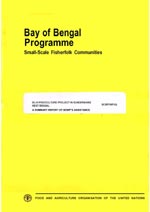|
PREFACE
This paper summarizes technical assistance
provided by the BOBP to a silvipisciculture project in the
Sunderbans, West Bengal. The project was implemented by the
forest department of the West Bengal Government, and funded by
SIDA (Swedish International Development Authority) between 1983
and 1988.
BOBP assistance was provided in the form of
four consultancy assignments between end-1986 and early 1988, and
related to the pisciculture aspect of the project. Specifically,
it concerned advice on the development of high- yielding
acquaculture techniques, and the construction of appropriate
cost-effective sluice designs; and a social feasibility study to
stimulate people’s participation in the project.
The Bay of Bengal Programme aims at
developing, demonstrating and promoting technologies and
methodologies to improve the conditions of small-scale fisherfolk
communities in seven member-countries—Bangladesh, India,
Indonesia, Maldives, Sri Lanka, Thailand. Assistance to the
silvi-piscicu!ture project was provided by the BOBP’s main
project, which was funded by SIDA in its first phase (1979-1986)
and is being funded jointly by DANIDA and SIDA during its second
phase, which began 1987.
|
